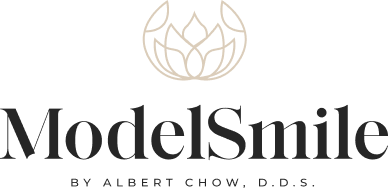Crooked or misaligned teeth can make you feel self-conscious and many people consider braces or veneers to improve the look of their teeth. It’s not just teenagers who receive braces anymore. In recent years, as many as 1.5 million adults also receive orthodontic treatment. These reasons cause many people to ask ‘What’s the difference between braces and veneers?‘ and Dr. Chow would like to help answer that for you.
Braces and veneers are different treatments that can both drastically improve your smile. They each have unique advantages depending on your degree of misalignment. Dr. Chow can help you determine which is appropriate for your individual situation.
What’s the difference?
In basic terms, veneers are considered cosmetic and braces are considered structural. Braces can fix anatomical misalignment or problems like an overbite, under bite, and cross bite, among others. Braces come in many forms, but Dr. Chow emphasizes Invisalign, a clear alternative to metal braces.
Veneers are used to fix cosmetic problems like discoloration, chips, stains, or small gaps between your teeth. They are attached to the front of your tooth and don’t require much maintenance aside from normal oral hygiene practices.
How do I know when veneers or braces are necessary?
No matter the degree of misalignment, you can opt for cosmetic dentistry or braces to feel better about your smile. If you are uncomfortable with some aspect of your smile, simple fixes can be made to boost your self-confidence.
On the other hand, some structural problems can cause pain, overcrowding, and make brushing or flossing more difficult. It may be time to consider braces or Invisalign if you have:
- Difficulty chewing or biting
- Difficulty speaking or you have a lisp
- Accidental biting of the cheek or tongue
- Abnormal teeth that make it difficult to close your mouth or lips
- Imbalanced or asymmetrical facial features
Structural problems can cause teeth to wear down unnaturally. Crowded teeth can cause difficulties with brushing or flossing that can cause cavities, gum disease, or other problems. Advancements in cosmetic dentistry and braces have also led to discreet treatment options and shorter treatment times.
About Veneers
Dental veneers are custom-made “shells” that fit over your existing tooth. They are typically made of porcelain and bonded to the front of your tooth, masking the look of chipped, discolored, or otherwise irregular teeth. The number of veneers required for a patient will vary depending on the number of teeth that need to be altered.
The porcelain can each be shaped and colored to match your existing teeth and create a seamless smile. Veneers can be applied in a few appointments, and last for 10 years or more with proper care.
Pros and Cons Associated with Veneers
When veneers are fitted, the natural tooth needs to be filed down. Your enamel will not grow back, and veneers will always need to be affixed to that tooth in order to avoid showing the tooth below.
One of the most appealing aspects of veneers is their short treatment time. After your initial consultation, it only takes 2 more appointments to mold and attach your veneers. You won’t have a special regimen to follow because veneers can be cared for just like the rest of your teeth.
About Braces
Braces are better suited for structural problems. Braces come in many forms but are typically associated with brackets that are bonded to each tooth. Our Malibu dentist offers Invisalign, which is a clear, discreet alternative to braces. Types of braces include:
- Traditional metal braces. They are made of stainless steel and are the most noticeable kind of braces.
- Ceramic braces look just like metal braces but can be colored just like your teeth so they are less noticeable.
- Lingual braces are very similar to metal braces but are attached to the insides of your teeth. They are undetectable from the outside, but are not suitable for severe cases.
- Invisalign are clear removable aligners that are made of clear plastic. A new aligner is required every few weeks to gradually move your teeth. They are the most discreet form of braces and can be removed while eating, drinking, and brushing your teeth.
The type of braces you appropriate for you will vary based on what structural problems you encounter, their severity, and your budget. As the premier Thousand Oaks Invisalign provider, Dr. Chow has the experience and technology to improve your smile without unsightly metal braces.
Braces – The Pros and Cons
Braces do not require filing of your teeth, so all of your teeth will remain intact after treatment is completed. They can also help with problems associated with cleaning your teeth, or a misaligned bite that can cause pain or other issues. Investing the time into braces will result in an aligned bite that alleviates pain, trouble chewing, and other problems with the jaw and bite. Invisalign can also protect your teeth from wearing down further while your bite is improved.
Braces take time because they gradually reshape your jaw for a more flattering smile. The average treatment time is one to two years, and you will also need to wear a retainer at night for several more years. Some patients are also concerned with the visible nature of braces, although Invisalign offers a discreet treatment option that is virtually invisible.
How do they compare?
The best treatment for your teeth will come down to the degree of misalignment. Veneers can be an alternative to braces in mild cases or those who simply want a cosmetic change. Braces or Invisalign may be better suited for moderate to severe misalignment or structural problems.
If you are not sure which is right for you, our Thousand Oaks dentist Dr. Albert Chow can help you evaluate available options. He brings an artistic eye and holistic approach to dentistry. After practicing for nearly 20 years, Dr. Chow can help you achieve a bright smile that you are proud to show off.


